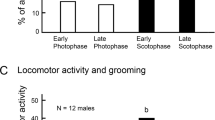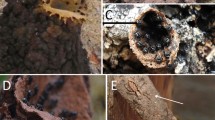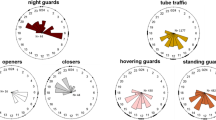This study aimed to identify the main quantitative characteristics of antennal grooming in healthy American cockroaches. The experiments reported here provide the fi rst evidence that on average, cockroaches cleaned the right antenna significantly more frequently than the left, indicating that healthy insects have functional asymmetry in relation to antennal grooming. At the same time, studies of grooming of the right and left basal segments of the antennae, and also the legs, showed that there were no significant differences in the number of cleaning acts. We suggest that the cause of the antennal grooming asymmetry is morphological asymmetry of the antennae and limbs and, perhaps, functional asymmetry of the brain.
Similar content being viewed by others
References
V. Ya. Gel’man, Solving Mathematical Tasks Using Excel, Piter, St. Petersburg (2003).
M. I. Zhukovskaya, “Odorant-dependent changes in surface cuticular secretions on the antennae of the cockroach Periplaneta Americana,” Sensor. Sist., 25, No. 1, 78–85 (2011).
E. I. Izvekov, V. A. Nepomnyashchikh, E. N. Medyantsev, et al., “Asymmetry in the direction of movement and morphological characteristics in roaches (Rutilus rutilus),” Asymmetriya, 2, No. 1, 21–31 (2008), www.j-asymmetry.com .
A. Ya. Karas’ and G. P. Udalova, “Spatial-motor asymmetry in the crab Carcinus meanas in active avoidance reactions,” Vestn. Leningrad. Gos. Uni. Ser. 3, 10, No. 2, 116–119 (1988).
D. V. Lychakov, “Lateralization of behavioral reactions and otolith asymmetry,” Zh. Evol. Biokhim. Fiziol., 49, No. 4, 299–311 (2013).
G. P. Udalova, M. I. Zhukovskaya, and A. Ya. Karas’, “Spatial-motor asymmetry in ants in conditions of multiple rearrangements in maze skill,” Vestn. Leningrad. Gos. Uni. Ser. 3, 1, No. 3, 67–75 (1992).
G. P. Udalova, A. Ya. Karas’, and M. I. Zhukovskaya, “Asymmetry in movement direction in gammarus (Gammarus oceanicus) in an open field test,” Zh. Vyssh. Nerv. Deyat., 40, No. 1, 93–101 (1990).
A. Bisazza, L. J. Rogers, and G. Vallortigara, “The origins of cerebral asymmetry: A review of evidence of behavioural and brain lateralization in fishes, reptiles and amphibians,” Neurosci. Biobehav. Rev., 22, 411–426 (1998).
B. J. Bobula Smith and B. D. Valentine, “Phylogenetic implications of grooming behavior in cockroaches (Insecta: Blattaria),” Psyche, 92, 369–385 (1985).
R. Cooper, N. Nudo, J. M. Gonzales, S. B. Vinson, and H. Liang, “Side-dominance of Periplaneta americana persists through antenna amputation,” J. Insect. Behav., 24, No. 3, 175–185 (2011).
I. O. El-Awami and D. R. Dent, “The interaction of surface and dust particle size on the pick-up and grooming behaviour of the German cockroach Blattella germanica,” Entomol. Exp. Appl., 77, 81–87 (1995).
W. H. Elder, “The oil gland of birds,” Wilson Bull., 66, 6–31 (1954).
E. Frasnelli, “Brain and behavioral lateralization in invertebrates,” Front. Psychol., Article 939 (2013).
E. Frasnelli, G. Anfora, F. Trona, et al., “Morphofunctional asymmetry of the olfactory receptors of the honeybee (Apis mellifera),” Behav. Brain Res., 209, 221–225 (2010).
E. Frasnelli, G. Vallortigara, and L. J. Rogers, “Response competition associated with right-left antennal asymmetries of new and old olfactory memory traces in honeybees,” Behav. Brain Res., 209, 36–41 (2010).
N. Freund, The Functional Architecture of Visual, Hemisphere-Specific Processing and its Development in Birds: DPh Thesis, Bochum, Germany (2009).
P. Graystock and W. O. H. Hughes, “Disease resistance in a weaver ant, Polyrhachis dives, and the role of antibiotic-producing glands,” Behav. Ecol. Sociobiol., 65, 2319–2327 (2011).
T. F. Hlavac, “Grooming systems of insects: structure, mechanics,” Ann. Entomol. Soc. Am., 68, 823–826 (1975).
A. Jennett, G. M. Rubin, T. T. B. Ngo, et al., “A GAL4-driver line resource for Drosophila neurobiology,” Cell Rep., 2, 991–1001 (2012).
D. Kovac and U. Maschwitz, “Secretion-grooming in the water bug Plea minutissima: a chemical defence against microorganisms interfering with the hydrofuge properties of the respiratory region,” Ecol. Entomol., 14, 403–411 (1989).
G. R. Lipton and D. J. Sutherland, “Activity rhythms in American cockroach, Periplaneta americana,” J. Insect. Physiol., 16, 1556–1566 (1970).
I. Lusebrink, K. Dettner, and K. Seifert, “Stenusine, an antimicrobial agent in the rove beetle genus Stenus (Coleoptera, Staphylinidae),” Naturwissenschaften, 95, 751–755 (2008).
D. V. Lychakov and Y. T. Rebane, “Fish otolith mass asymmetry: morphometry and influence on acoustic functionality,” Hear. Res., 201, 55–69 (2005).
S. Ocklenburg and O. Güntürkün, “Hemispheric asymmetries: the comparative view,” Front. Psychol., 3, 1–7 (2012), www.frontiersin. org.
A. Pascual, K.-L. Huang, J. Neveu, and T. Preat, “Brain asymmetry and long-term memory,” Nature, 427, 605–606 1(2004).
Y.-S. Peng, Y. Fang, S. Xu, and L. Ge, “The resistance mechanism of the Asian honey bee, Apis cerana Fabr., to an ectoparasitic mite, Varroa jacobsoni Oudemans,” J. Invertebr. Pathol., 49, 54–60 (1987).
J. Phillips-Portillo and N. J. Strausfeld, “Representation of the brain’s superior protocerebrum of the flesh fly, Neobellieria bullata, in the central body,” J. Comp. Neurol., 520, No. 14, 3070–3087 (2012).
L. J. Rogers and G. Vallortigara, “From antenna to antenna: lateral shift of olfactory memory in honeybees,” PLoS ONE 3, e2340, doi: 10.1371/journal.pone.0002340.2008.
D. Schaller, “Antennal sensory system of Periplaneta americana L. Distribution and frequency of morphologic types of sensilla and their sex-specific changes during postembryonic development,” Cell Tissue Res., 191, 121–139 (1978).
L. Sreng, “Sensory asymmetries in the olfactory system underlie sexual pheromone communication in the cockroach Nauphoeta cinerea,” Neurosci. Lett., 351, 141–144 (2003).
J. Verhaal, Lateralized Effects of Learning in the Avian Brain: the Influence of Top-Down Modulation: DPh Thesis, Ruhr-University, Bochum, Germany (2010).
C. M. Vincent and S. M. Bertram, “Crickets groom to avoid lethal parasitoids,” Anim. Behav., 79, 51–56 (2010).
A. Weisel-Echler, G. Haspel, and F. Libersat, “Venom of a parasitoid wasp induces prolonged grooming in the cockroach,” J. Exp. Biol., 202, No. 8, 957–964 (1999).
A. Yanagawa and S. Shimizu, “Resistance of the termite, Coptotermes formosanus Shiraki, to Metarhizium anisopliae due to grooming,” BioControl, 52, 75–85 (2007).
M. I. Zhukovskaya, “Circadian rhythm of sex pheromone perception in the male American cockroach, Periplaneta americana L.,” J. Insect Physiol., 41, No. 11, 941–946 (1995).
M. Zhukovskaya, A. Yanagawa, and B. T. Forschler, “Grooming behavior as a mechanism of insect disease defense,” Insects, 4, No. 4, 609–630 (2013).
Author information
Authors and Affiliations
Corresponding author
Additional information
Translated from Rossiiskii Fiziologicheskii Zhurnal imeni I. M. Sechenova, Vol. 100, No. 7, pp. 829–840, July, 2014.
Rights and permissions
About this article
Cite this article
Zhukovskaya, M.I., Lychakov, D.V. Asymmetry of Antennal Grooming in the Cockroach Periplaneta Americana . Neurosci Behav Physi 46, 160–167 (2016). https://doi.org/10.1007/s11055-015-0213-6
Received:
Published:
Issue Date:
DOI: https://doi.org/10.1007/s11055-015-0213-6




